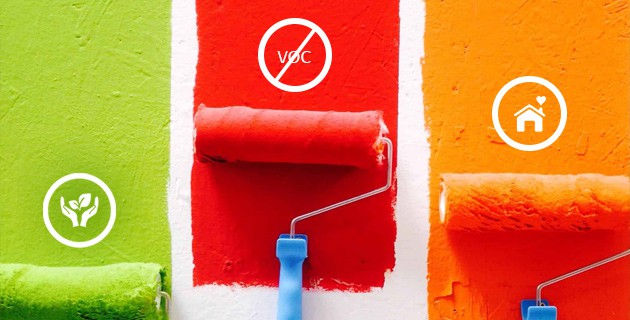This is the third post of my “Healthy Living Begins At Home” series- devoted to discovering how to make our homes and our clients’ homes places that support health and vitality.
Whether you are concerned about yourself, your newborn baby, larger family, or even your pet, an eco-friendly home reduces or eliminates toxins that are known to cause health issues including cancers. It also earns you LEED credits.
We all know that the lead-based paints of the past, which were banned back in 1977, led to mental disabilities in kids.
However, today our conventional paints still have known carcinogens in them, in what is referred to as “volatile organic compounds” or VOCs. Conventional house paint has benzene, methylene chloride, formaldehydes, and other VOCs that have been linked to cancer.
It is their offgassing which causes so many problems. It all begins with a highly toxic painting process. Then the offgassing can last for years and put us at risk for developing allergies, asthma, and cancer. Scary stuff.
Fortunately, there are healthy paints available in two categories: low-VOC and no-VOC. Low-VOC paints can have as much as 25 times more toxins in them as no-VOC paints. That is a huge difference and one that I wouldn’t overlook when painting my own home. I would settle for nothing less than no-VOC.
The current standard for low-VOC paint is 250 g/l for latex based paints, whereas a no-VOC paint must have less than 5 g/l. Oil based paints can have a bit more VOC in them to help them get their luster.
The VOC count in each bucket is recorded before mixing in the pigments, so the dyed paint will come out with a higher VOC count than the bucket says. Expect a jump of up to 150 g/l just from the dyes if you are not choosing the right (eco-conscious) brand. Some brands claim that their color pigments contain no VOCs, so make sure to enquire before purchasing.

If you live in California, or around Los Angeles in particular, there are different, higher standards for both of those regions, that essentially bans common VOC paints and puts a cap on low-VOC paints at 150 g/l.
The great news is that technology and market penetration has led us to have these low-VOC and no-VOC options at competitive prices. Many conventional paints cost more than no-VOC options, so don’t assume that price will exclude you from using them on your next project.
And, even if you don’t specify them for your next project, your painters might. More painting companies are waking up to the environmental hazards of applying high VOC paints on a daily basis and are only working with low and no-VOC paints.
Zero-VOC options include Sherwin-Williams' EcoSelect, AFM Safecoat, and Home Depot's Behr Premium Plus.

Regardless of where you purchase your paints, you’ll surely have low and no-VOC options.
Want to be a bit more safe and eco-conscious? Go vegan organic. (Really)

Prince Harry and Meghan Markle are using a vegan, odourless, non-toxic, eco paint by the Organic and Natural Paint Company to decorate their new baby's nursery. Their eco-friendly paints are all baby and pet safe, cruelty-free, non-toxic, odorless, as well as being shellac, cadmium and arsenic free. (And, free of diary and beeswax, both of which sometimes appear in other paints).
The Organic and Natural Paint Company provide their own advice on paint buying:
“Ideally you would be looking for paint lower than 1g of VOC per litre. Also, make sure you request the FULL ingredients list from the manufacture before you purchase and actually check for yourself, as there are a LOT of companies that sit high up in the search results that are claiming to be something they are not. DEMAND VOC certificates, and demand a full ingredients list - this is the only way to be sure (and safe). The health of yourself, and your family is at risk. It’s worth the extra few minutes of research!”
Yes, they are recommending less than 1 g/l- about 5x more stringent than our American no-VOC standards. You just can’t be safe enough when protecting your health.
Buying ecological products is good for the health of everyone involved- the painters, the homeowners, and their family, as well as pets and the environment.


